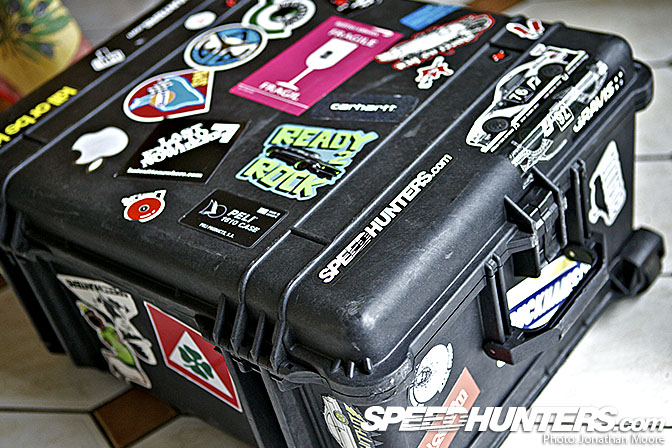

What started in a volcano ended in a volcano: the ash from the Icelandic volcano in April to the Argentinian volcanic lake in December, it was quite a year. Oh, let’s not forget the the sunstroke-fuelled proto Speedhunters volcano in Paul Ricard. In 2010 I covered two GT championships for Speedhunters, and 12 months, 14 countries, 39,954 miles, 38 races and 24,000 shots later, here I am at the beginning of another year in my love affair with sportscar racing. 12 months later, and still my text editor tries to auto-correct sportscars to sportswear. 12 months later, and still my cameras are being treated as punch bags (though my 5d MKII is currently undergoing the camera equivalent of the C3-PO oil bath I’m pleased to say). 12 months later, and my originally pristine Peli Case is now bedding in nicely, slightly bashed, well covered in stickers, but very much still doing its protective duty.
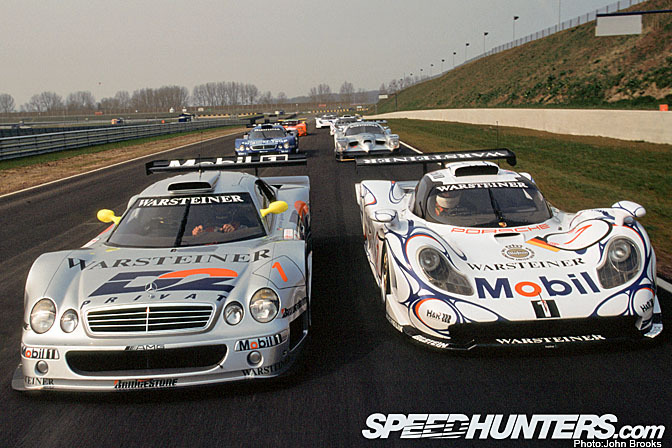
For my final contribution to Behind The Scenes month I thought I’d put together a summary of the events that happened around the races I went to last year, to give a flavour of a whole year of Speedhunting. I grew up on the South Bank at Brands Hatch (not literally, though likely my father sometimes wished he could have left me there), so sportscars have always been top of the list for me. As a 12-year-old watching the iconic Rothmans-liveried Porsche 956s battle the beautiful Martini-striped Lancias, these cars and that style of racing left an indelible impression. I’ve followed the FIA GT championship since its incarnation in 1997, where for a couple of years it even challenged F1 for manufacturer involvement and crowd excitement. 1997-98 were the glory years with brain-smashingly fast cars that combined grace and viciousness like a pack of sharks. Much to my disappointment I never saw these cars live on track but I watched the races on TV and my god they were amazing.
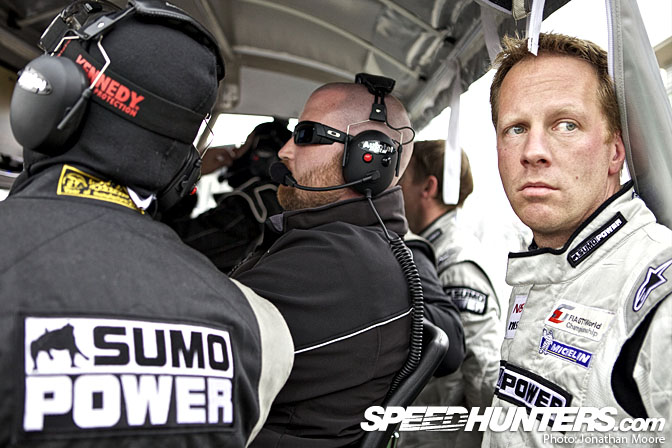
Then Bernie got angry, gnashed his teeth and manufacturers were effectively banned from GT racing. But the racing was still good even without the big bucks of car makers, and the specialist teams came into ascendancy. French Oreca Vipers won in ’99, Lister, with their screaming Storm, in 2000 followed by Larbre Vipers, Prodrive’s Ferrari 550s and then Vitaphone’s Maserati MC12 – the latter winning again and again. And again. Fast forward a dozen years and the drivers are still familiar: Jamie Campbell-Walter, 2000 FIA GT champion, drove for Sumo Power in one of their their Nissan GT-Rs. Christophe Bouchut, eternal bad boy, was champion in 2001 and 2002 and an All-Inkl Lamborghin pilot for the majority of the 2010 season until one of his legendary strops saw him thrown out of the team. SRT Nissan driver Karl Wendlinger was in a Viper; multiple FIA GT champion Michael Bartels drove a Zakspeed Porsche 911 GT1-98; FIA GT3 Team Need For Speed’s Claudia Hürtgen drove a Roock GT2 Porsche 911 in ’98. With the GT1s being given World Championship status for the first time, It wasn’t too difficult a decision to accept the challenge of covering the two FIA series.
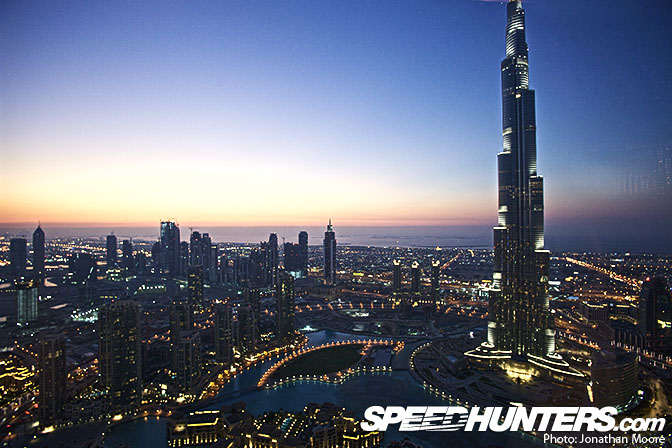
The racing season usually starts in late March, but of course for Speedhunters there’s no break. I kicked off with the Dubai 24 Hours in January, which was quite a way to start a year – as it was in 2011 as well. I took an early evening flight which dropped me into Dubai at about 2am. There then followed a surreal journey from the airport to the insanely decadent Address Downtown hotel in the back of the hotel’s BMW 7-series taxi (though taxi doesn’t do justice to its sumptuous leather) drinking in the SciFi light-show of the towering downtown Dubai area.
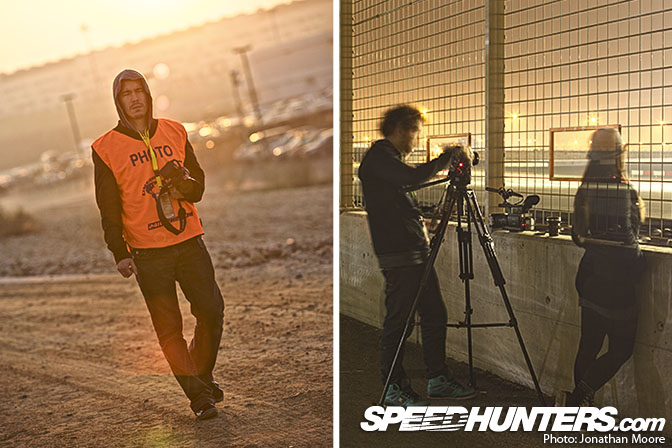
We had a full team complement on hand: Creative Director Rod, me, Will on video duty and the irrepressible Miki Taka heading up interviews.
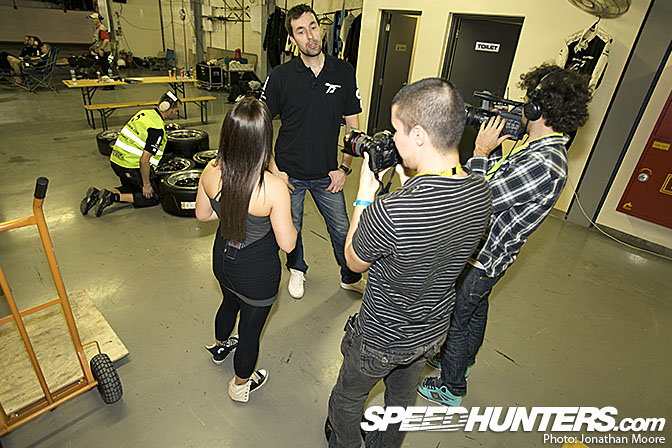
This was one of those times where you can see that a driver would rather be doing anything rather than having three cameras pointed at him, especially at silly o’clock in the morning. Poor old Patrick. I think he was just thinking about sleep…
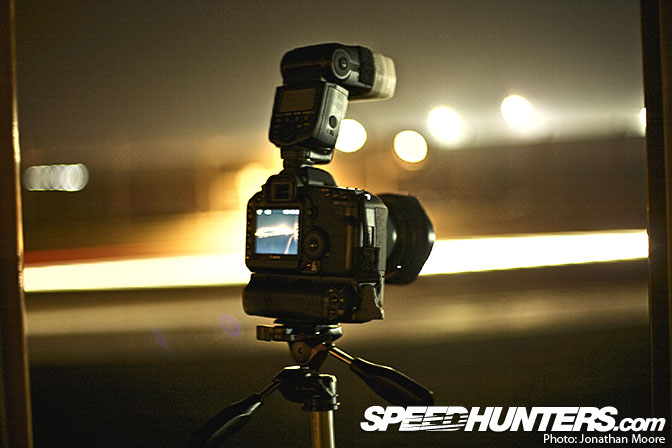
It’s a real drag having to lug around one piece of kit that you know you’ll only use once or twice – for me, my tripod is that kit. Lightweight it might be, but it takes up valuable space in luggage – always the biggest factor for airline travel. But once it’s night-time all is forgiven as the tripod comes into its own and you go for longer and longer exposures.
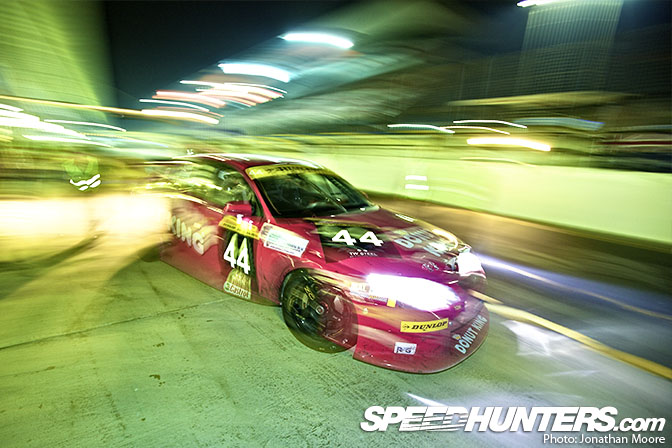
Night racing is just the best. There’s so much variation of shot that you can go for. And I really shouldn’t complain about my toy-like tripod, after seeing the hefty lumps of iron Will was having to carry about for shooting video.
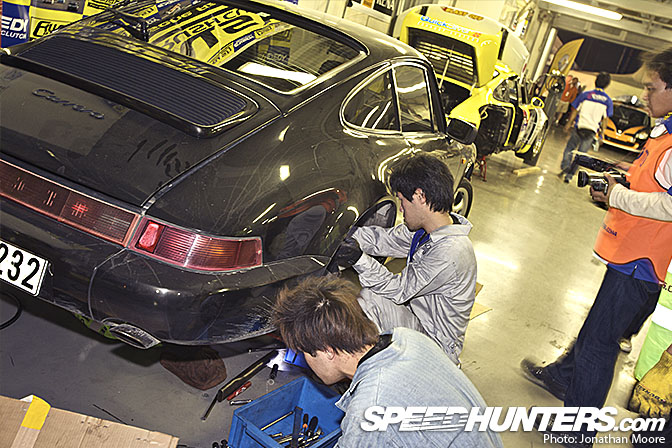
Aside from the magical 15 minutes of sleep I had in 40 hours and the emergency contact lens fluid provider, the moment that summed up this race for me was the sight of the Japanese Porsche team removing the rear suspension from an old road-going Carrera to their virtually destroyed racecar back on track. True grit.
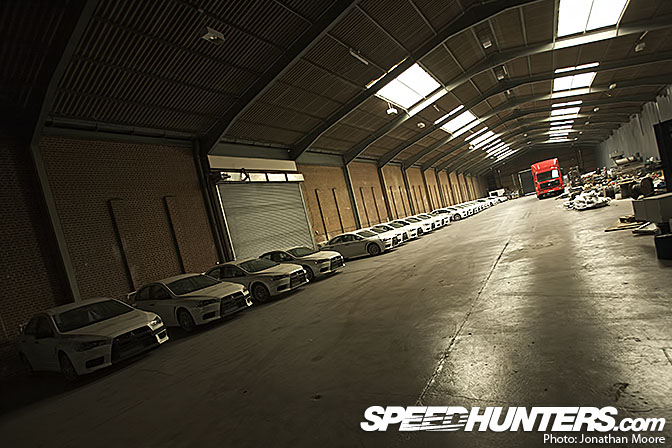
Almost as soon as I returned to the UK, Rod and I travelled down to the Sumo Power factory in Rye, and got our first view of the Nissan GT-R GT1 contenders that the team would be running in the GT1 World Championship. But just as exciting to see was the factory itself and the bits of rally history that were casually scattered around it. Makinens’ WRC Evo, a whole host of spares to from Mitsubishi’s WRC programme and, best of all, the warehouse full of Evo Xs.
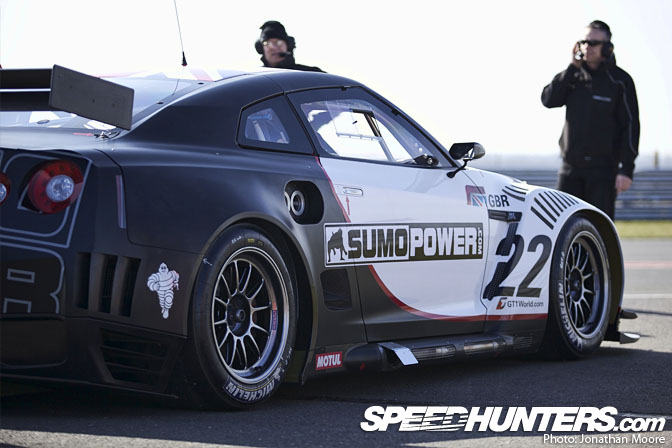
At the beginning of March I was off up to a wind-swept Snetterton, a popular test track in Norfolk, for one of Sumo Power’s first test sessions back in March. A single GT1 car was run out that day, for their then just-announced second driver pairing of Jamie Campbell-Walter and Warren Hughes.
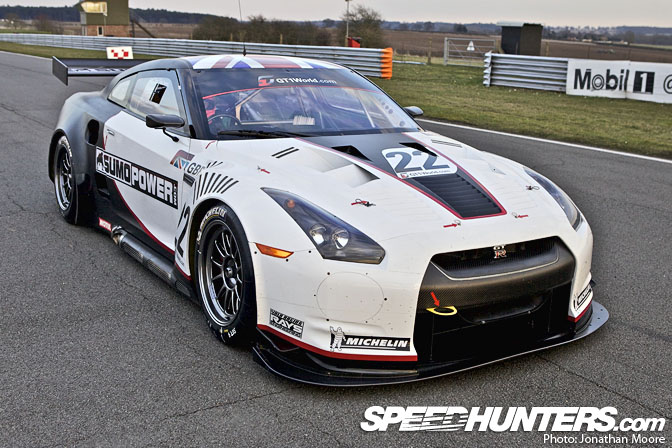
The team were friendly but guarded: no race team likes a photographer poking his lenses at them during testing, especially a team so new and with a car so early in its development. Racing is a tight-knit community, and most of the dozen or so Sumo Power crew on duty knew each other from previous teams. Arriving the night before the test, I had time for a quick drink with the team before everyone crashed out for the early start the next morning. It was interesting to get to know the characters and the dynamics of the team. As a sad racing anorak, these kind of evenings can’t be beaten: old hands recounting tales of racing glory and cars they’ve worked on, mostly including unrepeatable references to drivers or team bosses… Touring cars, Le Mans, single seaters and everything in between: the range of experience in the Sumo Power fold was impressive. As is their drinking ability, of course. The evening quickly devolved into an amusing argument between front- and rear-wheel drive proponents.
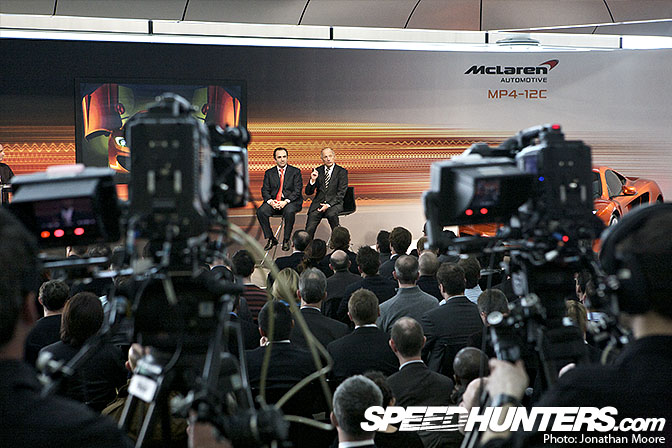
The journeys were getting shorter as I moved into Spring: just 15 miles round the M25 from my house is the McLaren Technology Centre. When Rod called out of the blue – as usual – asking if I could cover the launch of the MP4-12C, it didn’t take me long – as usual – to say yes. This was a change from normal: just visiting the MTC is incredible, but then the access and friendliness of the staff made it even more special. Standing at the back with the other photographers at the press conference segment of the launch was a surreal experience. I spent plenty of time nosing around the display of historical McLarens – the MTC must have felt strangely empty when most of the cars were shipped out to the NEC earlier this month for the Autosport show, where Paddy was able to get a good look at them.
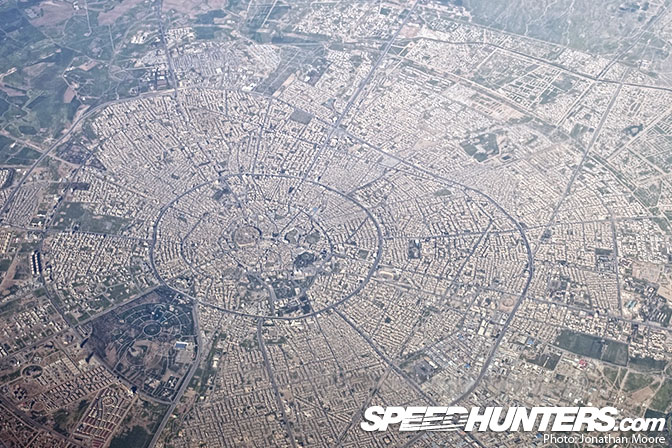
April came round fast, and it was time to travel out with the Sumo Power team to the opening round of the Word GT1 Championship at Abu Dhabi in the United Arab Emirates. The trip out was epic enough: flying over the deserts of Iraq and the city of Arbil in the north – one of the oldest continuously inhabited cities in the world. Little did I know how epic the return would be.
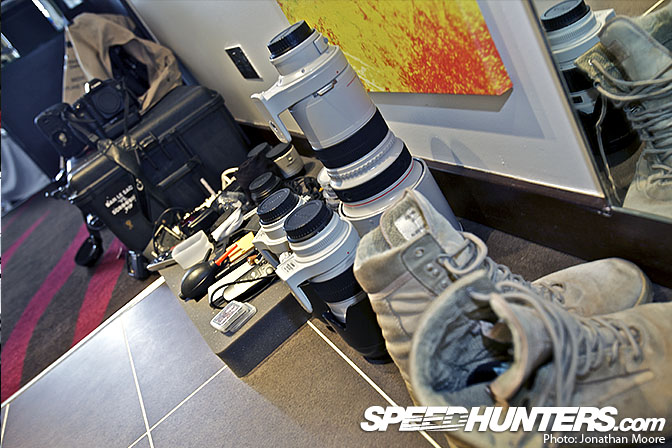
As I arrived in Abu Dhabi I also had my first panic of the year. Leaving the air conditioned airport we emerged into the hot and humid evening air: it hit you like a wall of sticky heat and drenched you in sweat. After I checked-in to my hotel I did the traditional camera check: the difference this time was that it was the first trip for my new camera case, which had to go in the hold. As I pulled out my wide-angle lens from the case it rattled. Rattled. Lenses aren’t supposed to do that… Everything was also covered in a layer of condensation. Utter horror hit me: I took a test shot. Blurry. Oh my god. Did I not close the case properly? Not put in a silica gel sachet? Thanfully, logical thinking took over: I went back to the wide-angle and unscrewed the UV filter: it was just the glass in the filter that was loose! And the condensation was purely opening the case in an air-conditioned room after it had been outside in the humidity. A stiff drink later, I was feeling a lot happier. It also reminded me to always take a camera in hand luggage…
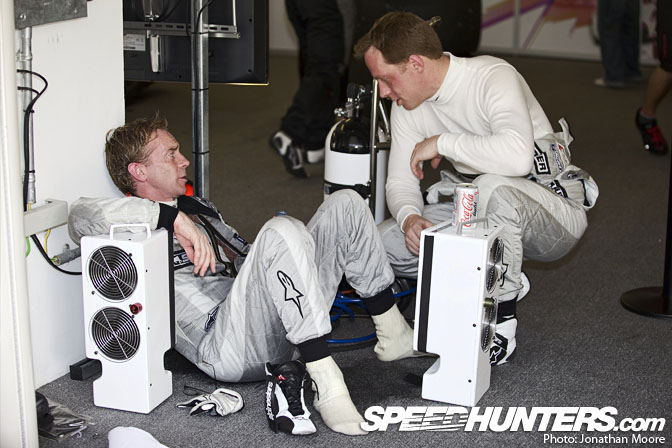
The operating environment at Yas Marina was harsh: the F1 garages and track buildings might have been air conditioned, but out on the track conditions were brutal. These guys are used to endurance racing – triple stints at Le Mans are normal – but even being out for half an hour in the extreme heat and humidity of Abu Dhabi was leaving the drivers exhausted. Without putting me in the same bracket of suffering, it was tough as well for us photographers: no shade and out in the heat of the day meant I lost a kilo in weight during the first day alone… Quite a way to diet. Thankfully the media shuttles round the track were frequent – and stocked with water and chocolate bars!
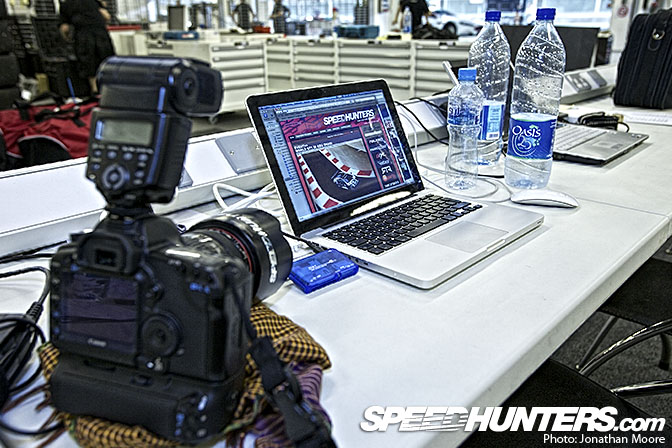
I had mostly camped out in a corner of the Sumo Power garage – the media centre was predictably plush and well-equipped, but the additional 100 yards there was sometimes 99 yards too far.
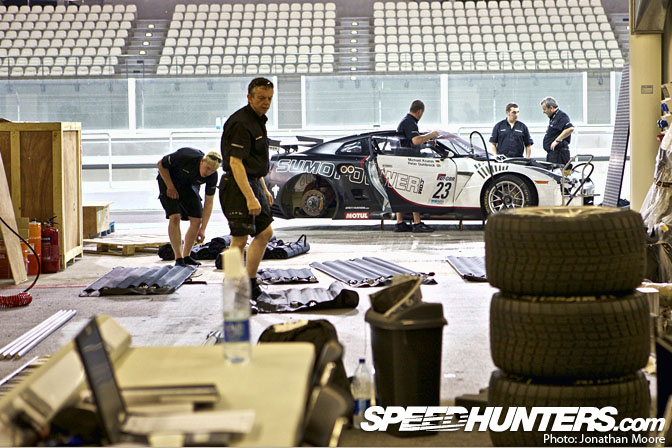
The races over, Sumo Power had a couple of battered GT-Rs to deal with, plus a whole garage of equipment to fit in a sea container. There’s no such thing as travelling light for a race team: that piece of kit you leave out of the toolkit will likely be the one thing you end up needing… The crews finished packing in the early hours of the morning and then trailed back in groups to the nearby hotels just outside the track perimeter. Time to go home? Yes. But not if the Icelandic volcano had anything to do with it.
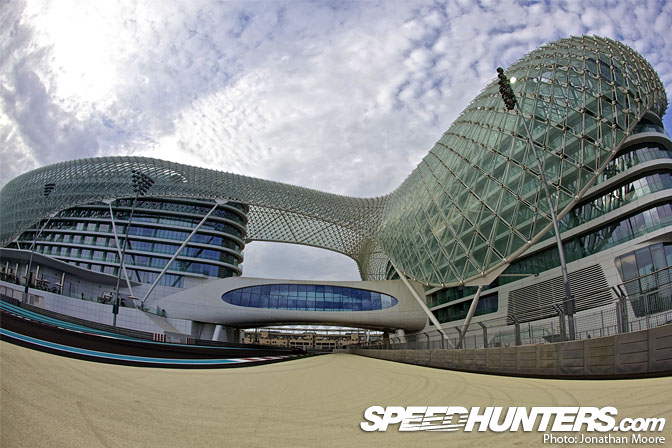
Next morning (or, well, afternoon if I’m honest) as people padded down into the hotel foyers, the situation became clear. It wasn’t that some people wouldn’t be getting back, or that the cars were stranded. Everything and everybody was stuck. All 500-odd people involved in the GT1 circus, stuck. Airline staff, with straight faces, informed the teams’ travel managers that the first flights out would likely not happen for two weeks. Ie, after the next round was due to take place at the Silverstone circuit in the UK! Unless they held round two at Yas Marina as well…
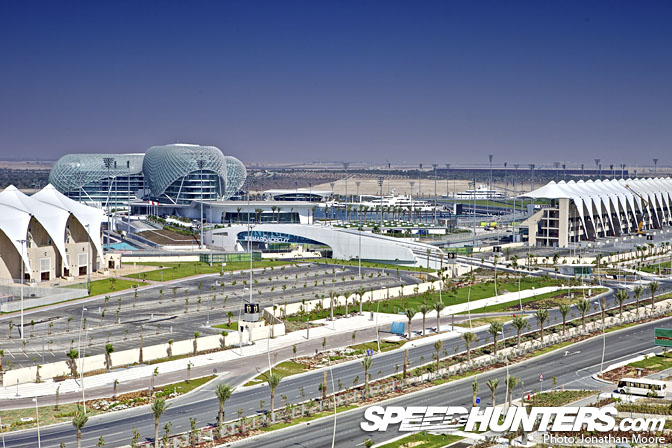
The rest of Sunday was fine: finishing up stories, more photo editing. Monday was okay: watching the F1 race in the most convoluted way I could find (remote connection to my Mac in the UK, export the PVRd race to my work FTP, download the video to my laptop in Abu Dhabi). The Yas Hotel and Yas Marina track were visible right outside my window. Then the days started to drag.
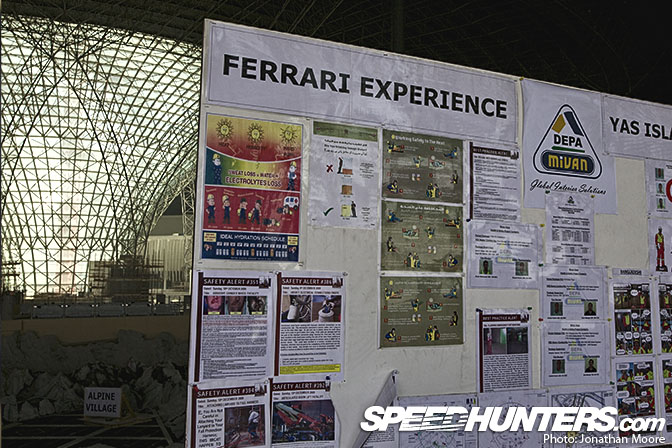
Despite the room service and luxury, I’m not a person who likes to sit about doing nothing: hence my idiotic decision to venture out in the midday sun on the Wednesday and try and infiltrate the still-under-construction Ferrari World. Which I managed without being arrested, happily. Though I did get thrown out eventually, after I’d penetrated the Death Star core of the building. I liked the Alpine Village sign in the middle of a pile of rubble. Amazing – I’m looking forward to visiting the finished thing if I do make it out there this year. Though I might give the rollercoaster a miss.
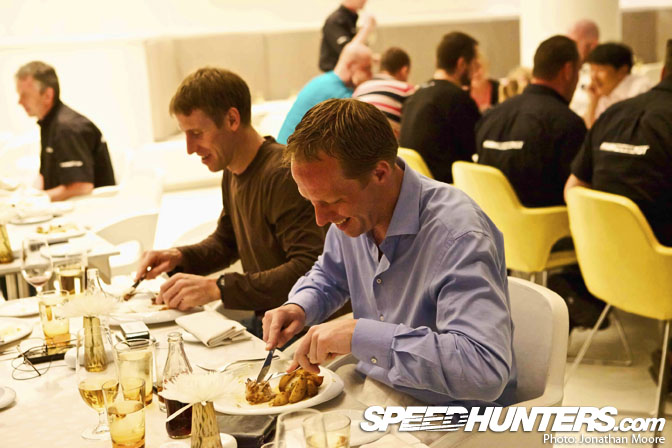
Cabin fever had been building up despite the luxurious surroundings, and everyone just wanted to get home. The 24 GT1 cars were finally being put on a cargo flight back to Europe, and teams were finding whatever ways they could to get people home. LIterally planes, trains and automobiles. Sumo Power team chief James Rumsey decided on a mercy flight for his team and, thankfully, me too. There’s only one word that can sum up the journey home: epic. On Thursday evening, Sumo Power got together for a last supper at the Yas Marina hotel. Somehow the drivers had been squeezed onto one of the rare-as-hen’s-teeth commercial flights that was scheduled. They were pretty cocky about the whole thing and betting on their chances of beating the rest of the team home.
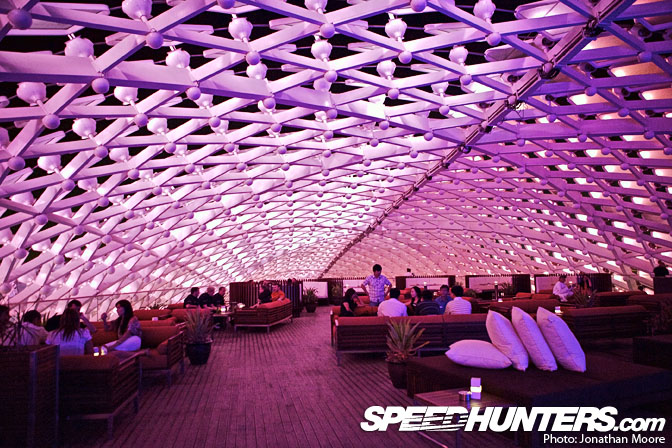
With an hour or so to kill before the buses left for the airport at midnight, most of the team headed upstairs to the amazing bar on the top floor of the Yas Marina hotel. The track runs around three sides of the hotel, and from the bar you can look down on the cars below during the race. But even without the sounds and sights of racing, the bar itself was stunning: an overload of shifting lights under the skeletal shell roof. And great cocktails. Really great cocktails.
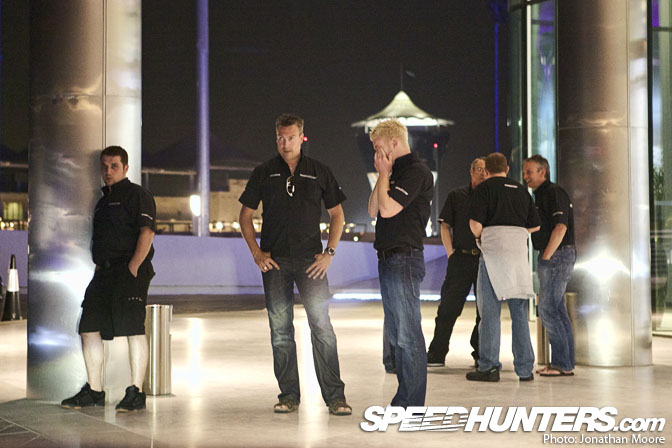
Around 11.30pm it was time to head to the hotel to grab cases and load up the buses. Already eyes were drooping, but at this stage nobody realised just how long a journey we had ahead of us.
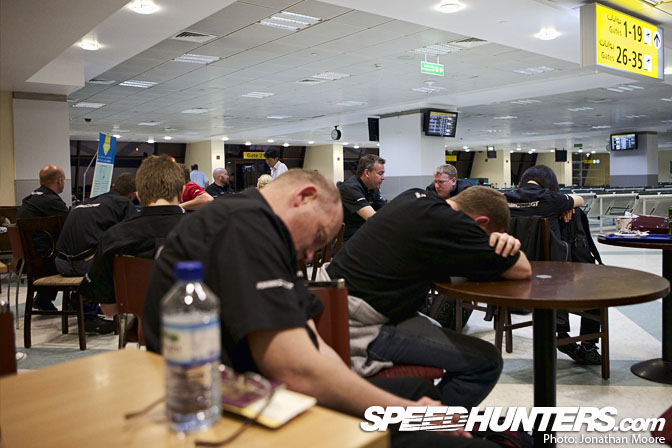
Although it was a chartered flight all the airport protocols had to be followed for an international flight: arriving two hours ahead, security, passport control… But that done, all we needed was a plane. It finally arrived around 2am. Now all that was needed was a crew. That didn’t turn up until after 4am. By this stage, understandably comatose was the best way to describe the Sumo Power team.
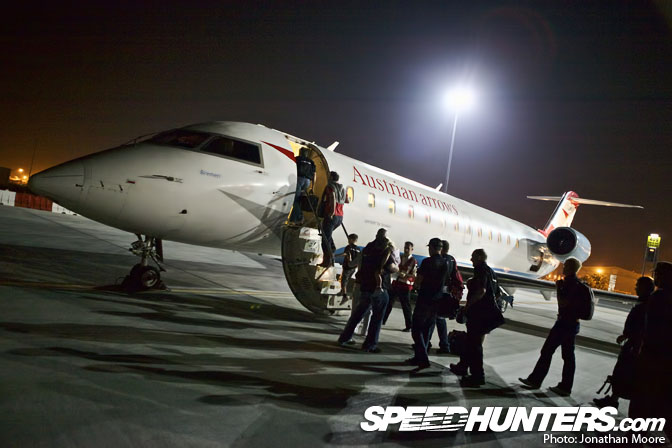
When the gate was finally opened, we struggled awake and down to the waiting coach, which took an interminably long route to the parked plane. The longer we drove, the longer it appeared we were driving all the way back to England. Great. But finally the floodlit plane was in sight and we were stumbling up the stairs, collapsing into the first available seats.
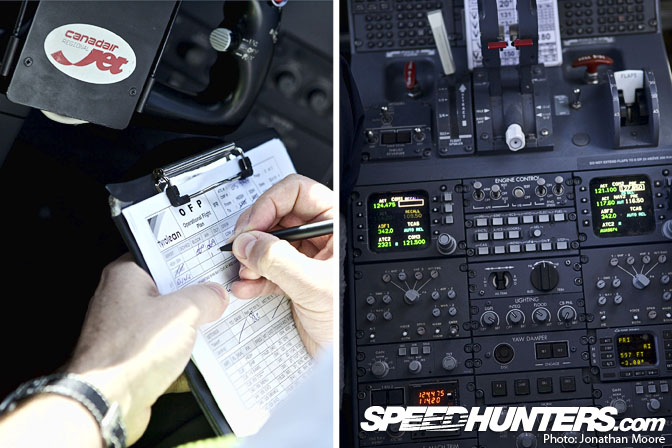
The first scheduled stop was due to be Damascus in Syria – the Canadair RJ200 had a three-hour effective range, so the flight would take two hops on its way to Vienna in Austria. 5, 6, 7am… we all drifted in and out of consciousness, bodies by now completely unaware of what the ‘real’ time was. But then I felt the landing gear jolt the plane: landing time! In… Egypt?! For some reason the plane had been denied clearance to land in Syria – even though it had stopped off on the way down – so had to divert to Sharm El Sheik, right at the limit of its fuel. Hours were lost on the ground as the pilot negotiated to buy fuel with his credit card! Everyone was stuck on the plane, trying to stay asleep and turning this way and that to get comfortable in the cramped cabin.
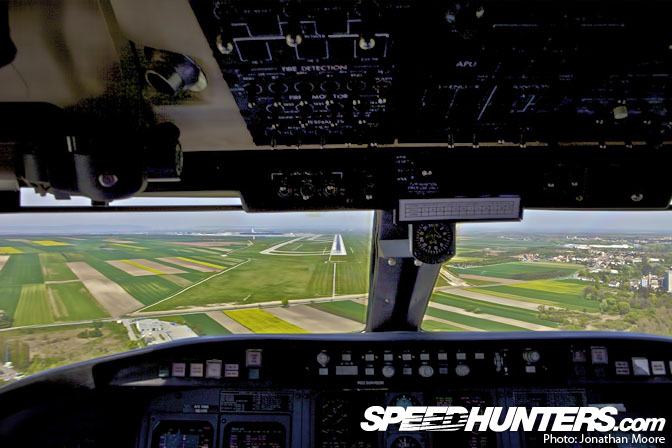
Finally we were in the air again and on our way north. Amazingly, the volcanic dust cloud was visible on the horizon as a thin black line: proof that it was a real phenomenon and not an airline excuse! It’s not often you get the chance to ride up in the cockpit of a jet – and even less that you get to sit in the jumpseat when it lands! Despite being dog tired, that was quite a thrill! Many thanks to the captain and co-pilot – and the lovely air hostesses… We landed in Vienna at around midday local time: already five hours behind schedule. Of more concern was the cheery pilot telling us that they’d landed on fumes, as the leg from Egypt to Vienna was technically too long for the plane. They’d climbed as high as they could, stuck it on low-powered cruise and put their feet up. Pilots are a different breed. Like racing drivers…
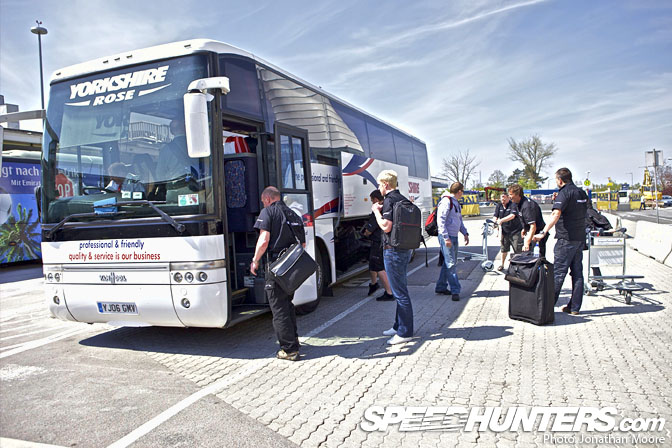
Next up: a marathon coach trip across northern Europe: from Vienna, through into Germany and then to France and the Channel Tunnel. 18 hours and a bad back later, the Channel Tunnel train shipped us back to England for the final leg to the Sumo Power factory in Rye on the south coast. From there the team dispersed back to their homes – with just a week to prepare for the second round of the championship at Silverstone. Abu Dhabi had a been a tough intro on every level, but proved a bonding experience to the new team. And yes, the drivers beat us home.
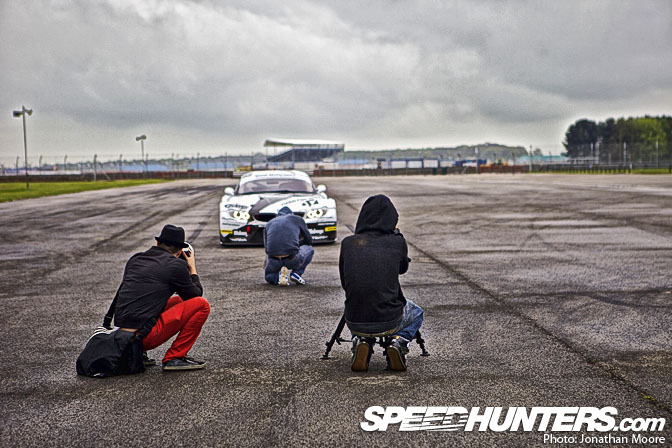
Bump. A week later I was in Northamptonshire for the second GT1 round at Silverstone. The Speedhunters team had gathered again, with Linhbergh joining us this time – swapping West Coast chilling for a Midlands chill. This was my first view of the BMW Z4 Coupé that Schubert Motorsport would be running for Team Need For Speed’s Patrick Soderlund and Edward Sandstrom. At least a car can’t complain about having so many cameras pointing at it.
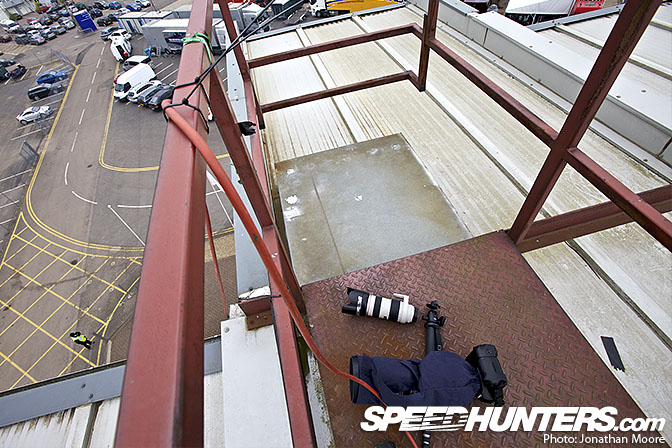
I have a really bad habit of wanting to go anywhere where there’s a no entry sign. Sometimes it works: ta-dah! Magic shot opportunity! But at Silverstone, after negotiating my way onto the roof of one of the grandstands I was very much caught out. After 20 wind-swept minutes, iPod on as I snapped away and congratulated myself on being so clever I heard the bang. Of the trapdoor swinging shut, leaving me stranded four floors up. The security guard below just didn’t understand my ‘door shut; stuck here; can’t get down’ sign language and gave me a smiling thumbs up before walking off. Ace. Luckily at the session’s end I managed to get someone’s attention and get down. Had I learned a lesson? Of course not.
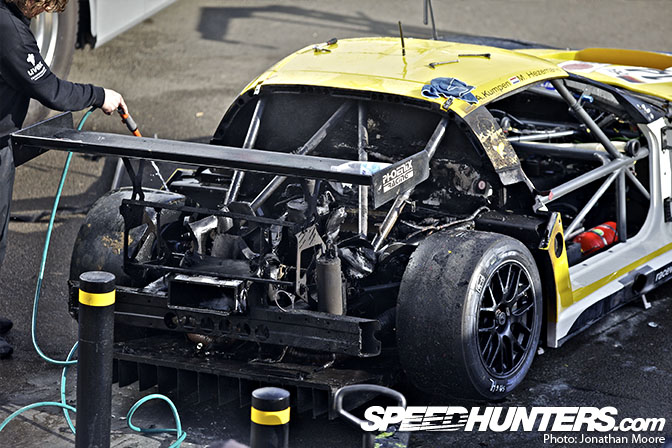
A gentleman’s toilet is not the best place to be discovered with a camera, standing on a chair. I now know this. But it was the best place to get a quick elevated shot of the charred remains of the Phoenix Corvette being hosed down by its disconsolate crew. Amazingly, this car has been rebuilt and will be racing in Holland this year: but there’s virtually no chance of Corvettes reappearing in World GT1.
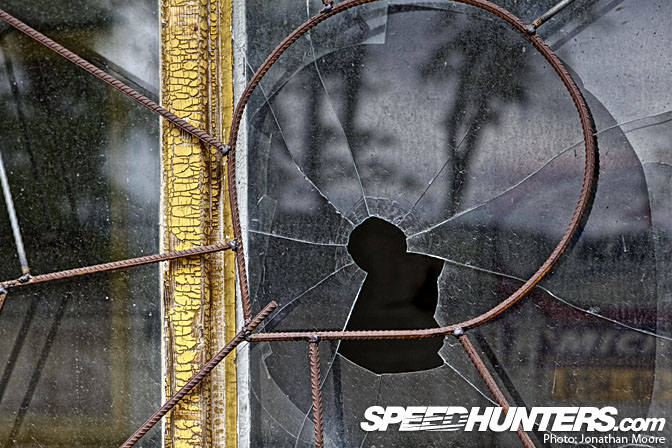
After a hateful flight on RyanAir, truly the world’s rudest and most unhelpful airline, the next round was Brno in the Czech Republic. A strange mixture of Cold War decay and friendly optimism. And too much drizzling rain for my liking.
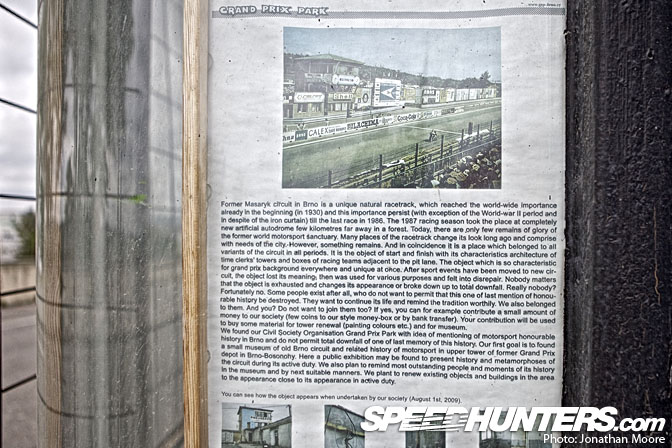
Brno has a long history of racing: the town boasts that petrol runs through its veins, and with eighty years of racing heritage in the area they’re got the right to say that. The original street circuit was christened in 1930 and ranks up there with the cream of the European road racing tracks of that era. As kids (and adults as well, in all probability), I’m sure we’ve all sketched out tracks based on the local area where we live. At the turn of the 20th century and the birth of the European racing scene, this was exactly what happened in Brno.
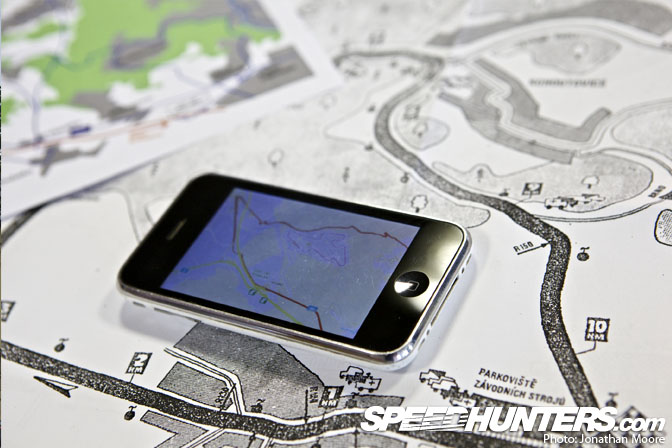
Armed with a photocopy of the track layout and an iPhone, I went for a tour round the old circuit. Built in 1930, it was over 18 miles long and used until 1948 when the western half of the track was effectively chopped off. This shortened 11 mile configuration was in turn used until 1964 when another yet section was lopped off, and then 1975 when the eastern end that went through Brno was also removed. But even the remaining section was still almost 7 miles long!
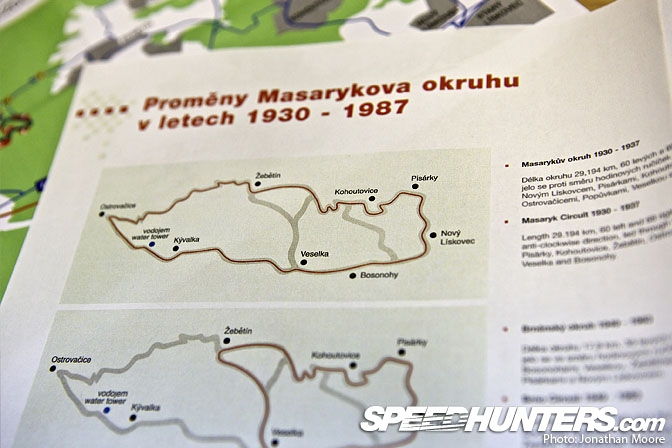
’80s touring cars were, frankly, awesome.
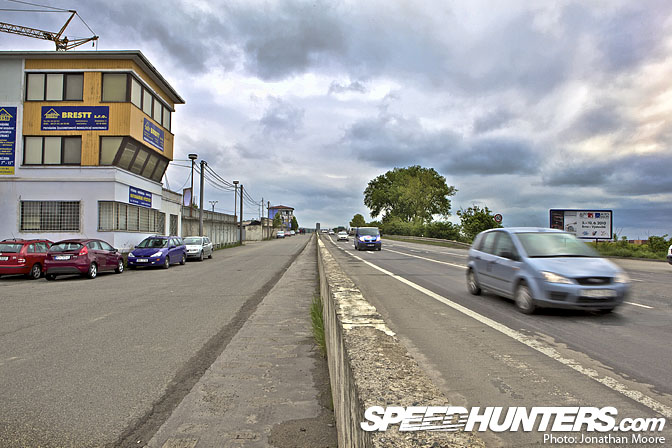
It was a real shame that the pits are so decayed. Crumbling concrete and peeling paint sum up the place, which by necessity has been taken over by a local spare parts and second-hand tyre dealer. There’s a local group trying to keep the place from further damage, but I can’t see this getting the same treatment as, for instance, Reims in France. Sadly this is more likely to go the way of Rouen and be utterly erased at some stage, which will be a real shame.
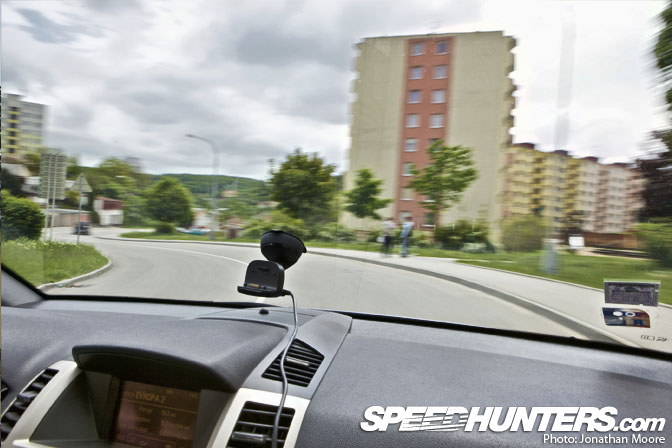
Brno had three distinct parts: the urban section, the long blast through the countryside and the undulating return leg through the forest.
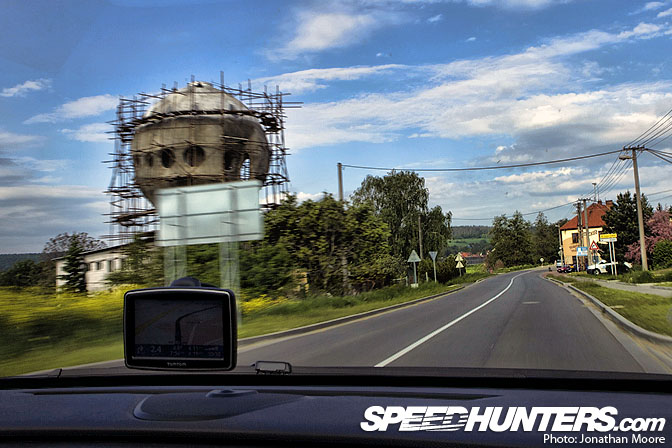
The most fun bit if definitely the forest section, which is fantastic fun even in a hire car… But the opening long straights and gentle kinks gave you more idea of the street track basis of the circuit, plus meant you could spot the more surreal architectural constructions in progress around the town.
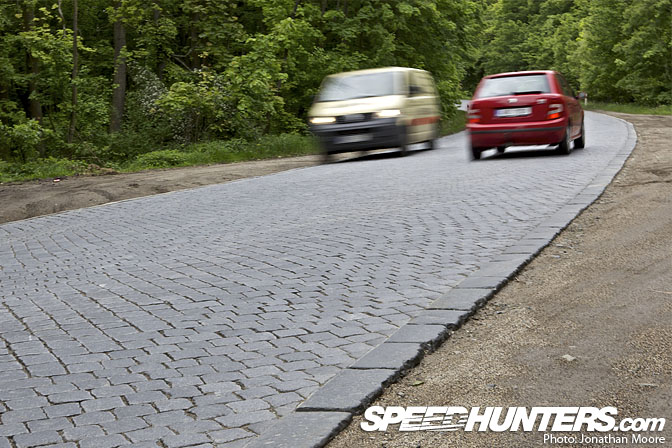
On the oldest surviving part of the track in the north you can see the original tiled road surface. This must have been absolutely lethal in pre-war Grand Prix cars. You can still make it round almost the entire 18 miles of the old track: there’s literally just one corner that’s been changed in the south-western corner in the town itself, but otherwise you can still enjoy a blast (at the legal limit of course) around this mother and father of all street tracks.
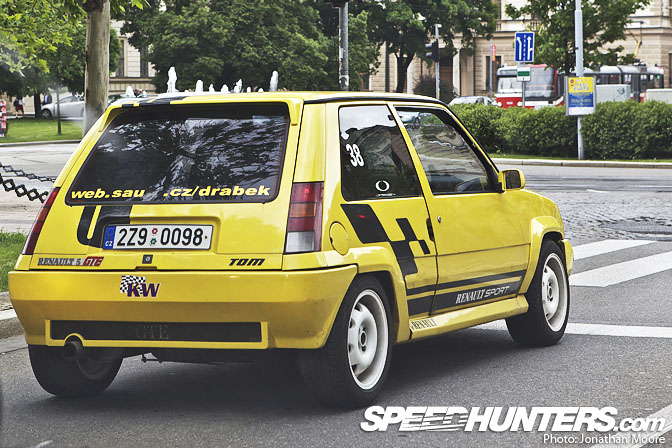
I went for a quick look around Brno town as well: tram lines still criss-cross the old town and the beer brewery is still doing a roaring trade. My best spot was this pristine Renault 5 though!
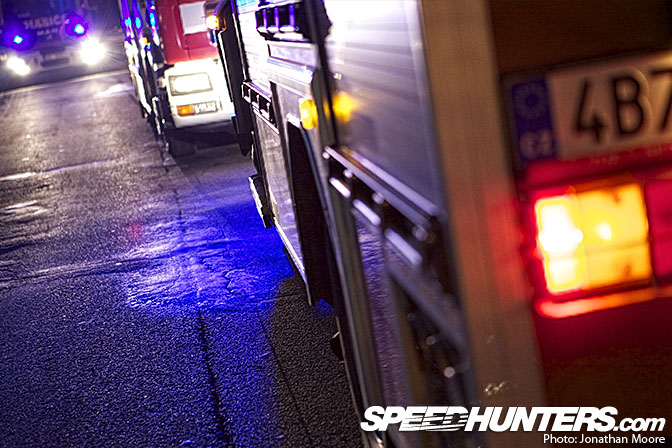
Another important lesson was flagged up on the final evening before flying out: if the team invite you to go out with them on an all-night session, go with them. I took what I thought was the sensible option of staying at the hotel, working on images and having an early night. The 4am fire alarm and evacuation put paid to that idea. Completely coincidentally it coincided with when a lot of very ‘happy’ GT1 team members stumbled in. Go figure.
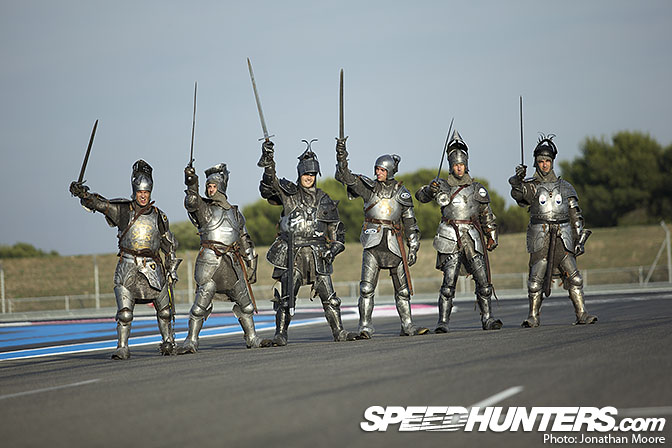
After a quick trip to Madrid for round three of the GT3s, I met up again with the Speedhunters gang at Paul Ricard in the south of France. I think this was another one where the shock of sun got to me. After all, surely I didn’t really see medieval knights?
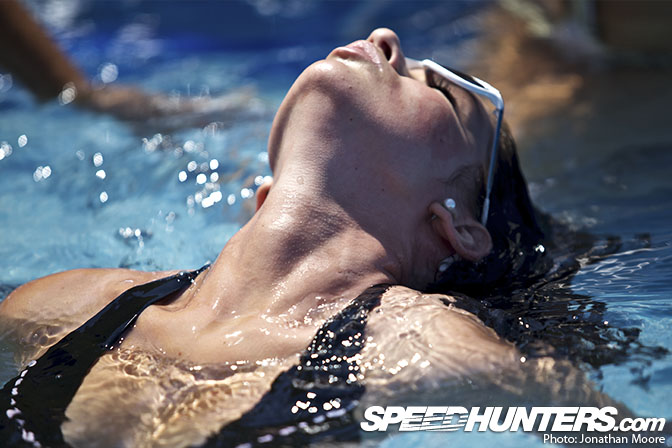
The sun is also my excuse for the ludicrous bandana I was sporting, that Will ambushed me with when filming his piece on the race. Being *forced* to take pictures of the Aston Martin’s Car Wash Girls tastefully cavorting in a paddling pool also didn’t help. It was time for a holiday.
Jonathan Moore

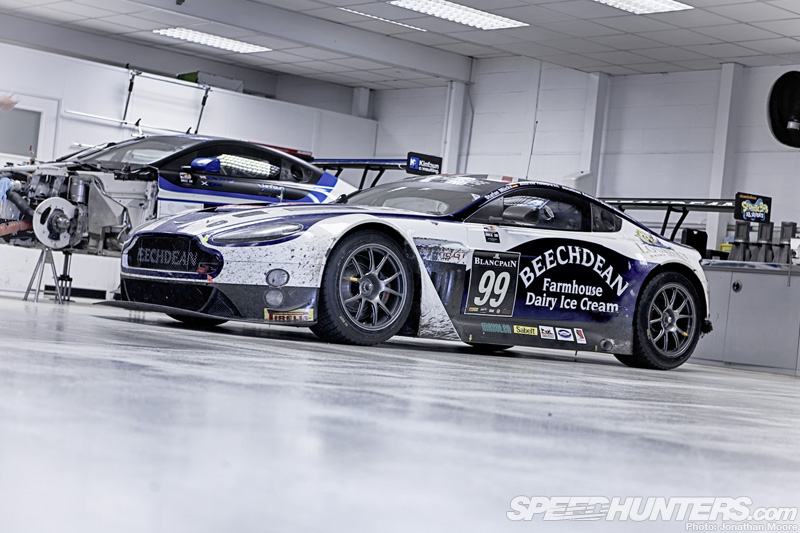






Awesome post Jonathan - photos are fantastic as always, but what a great read. Love all the team shots too - the team look so knackered at the airport. Looking forward to part 2. Although looking at the last shot, maybe it's not such a hard life?
woow, I am from Czech Republic
Awesome writeup, i'm jealous as hell
Great job Jonathan!
Seems like a very tiring but exciting year....
You pictures have amazing quality! What camera do you use? Canon Eos 450D?
Story of the month.
The Abu Dhabi and return trip was really fun to read. (not so to experience it, i imagine.
"Behind the scenes" should become recurrent on Speedhunters.
Awesome shots, the work that is put in to all the coverage is astounding. There should definitely be more behind-the-scenes coverage throughout the year.
Yes, this is my fucked country...
Congratulations Mr M-O-O-R-E !

It's just since a few days that i know why there's a Quadrifoglio verde sticker on your PELI case. If Volker didn't opened my eyes , i surely still believe that you are just another one super talented SH member !
I actually know that you are much more than that ( hahaha ! ) , and i don't know why exatctly , but i'm secretly a bit proud of this !
From that entire season , my best remenber is your focus on Jamie Campbell-Walter come back ( on first rows of the grid ) , and i deeply thank you for this.
I understand now why all your travels all around the world did put some distance between us , and well , weirdly i'm quite happy with that !
Congrats mon ami , waiting to read you here or.....elsewher
damn who ever said taking pictures was easy,,,shits a challenge i still would love to be a photographer for speed hunters i think it would be the best job ever
Still cool to see this BTS stuff. Still don't know where I can find the NFS BMW stickers, and I found another that I can't live without, the Ready 2 Rock RTR-X sticker.
Hey Markus! REALLY good to hear from you - and thank you for your kind words. I will see you on the VLM boards!

[T-Spark]
Miki Taka?!
Don't know how do you do all of this and moore.
Love the shot of the pristine Renault 5 - brings back very fond memories of the one I had back in the 80s during the ad campaign "What's yours called?" (Crappy! But she did 118,000 miles before her head gaskets blew up on the A1 doing 90mph....)